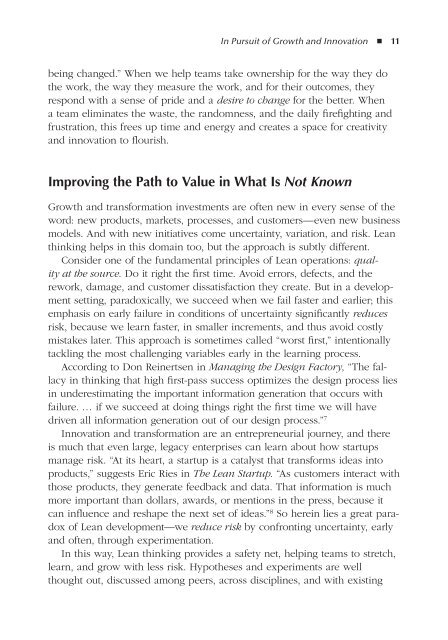Run-Grow-Transform-Chapter-One-distribute-freely
Run-Grow-Transform-Chapter-One-distribute-freely
Run-Grow-Transform-Chapter-One-distribute-freely
You also want an ePaper? Increase the reach of your titles
YUMPU automatically turns print PDFs into web optimized ePapers that Google loves.
In Pursuit of <strong>Grow</strong>th and Innovation ◾ 11<br />
being changed.” When we help teams take ownership for the way they do<br />
the work, the way they measure the work, and for their outcomes, they<br />
respond with a sense of pride and a desire to change for the better. When<br />
a team eliminates the waste, the randomness, and the daily firefighting and<br />
frustration, this frees up time and energy and creates a space for creativity<br />
and innovation to flourish.<br />
Improving the Path to Value in What Is Not Known<br />
<strong>Grow</strong>th and transformation investments are often new in every sense of the<br />
word: new products, markets, processes, and customers—even new business<br />
models. And with new initiatives come uncertainty, variation, and risk. Lean<br />
thinking helps in this domain too, but the approach is subtly different.<br />
Consider one of the fundamental principles of Lean operations: quality<br />
at the source. Do it right the first time. Avoid errors, defects, and the<br />
rework, damage, and customer dissatisfaction they create. But in a development<br />
setting, paradoxically, we succeed when we fail faster and earlier; this<br />
emphasis on early failure in conditions of uncertainty significantly reduces<br />
risk, because we learn faster, in smaller increments, and thus avoid costly<br />
mistakes later. This approach is sometimes called “worst first,” intentionally<br />
tackling the most challenging variables early in the learning process.<br />
According to Don Reinertsen in Managing the Design Factory, “The fallacy<br />
in thinking that high first-pass success optimizes the design process lies<br />
in underestimating the important information generation that occurs with<br />
failure. … if we succeed at doing things right the first time we will have<br />
driven all information generation out of our design process.” 7<br />
Innovation and transformation are an entrepreneurial journey, and there<br />
is much that even large, legacy enterprises can learn about how startups<br />
manage risk. “At its heart, a startup is a catalyst that transforms ideas into<br />
products,” suggests Eric Ries in The Lean Startup. “As customers interact with<br />
those products, they generate feedback and data. That information is much<br />
more important than dollars, awards, or mentions in the press, because it<br />
can influence and reshape the next set of ideas.” 8 So herein lies a great paradox<br />
of Lean development—we reduce risk by confronting uncertainty, early<br />
and often, through experimentation.<br />
In this way, Lean thinking provides a safety net, helping teams to stretch,<br />
learn, and grow with less risk. Hypotheses and experiments are well<br />
thought out, discussed among peers, across disciplines, and with existing<br />
TAF-K14527-12-0302-C001.indd 11<br />
13/08/12 8:25 PM


